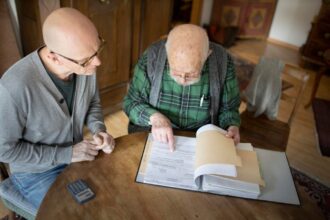You have worked all your life, what kind of wealth are you likely to have?
Here is the thing. Most older adults and households nearing retirement don’t have any significant stock holdings; people nearing retirement don’t have large amounts of home equity; most people nearing retirement have small or nonexistent retirement plans.
Wealth Is Falling
And, the typical American has less wealth in 2016 — the latest figures available for workers approaching retirement age — then they did in 1992. All these numbers are calculated from the Health and Retirement Survey by Siavash Radpour at The New School.
So, when Americans are finishing up their career and work and nearing retirement what do they have? In 1992, the median wealth for households with at least one worker aged 51-56 in 1992 was $654,926 (inflated to 2016 numbers); in 2016 they had much less, $466,900 What happened? Americans lost ground on every source of wealth!
· Median home equity fell from $91,160 to $60,000 a combination of because of second mortgages and less money down on a mortgage loan.
· Wealth held in traditional pensions, defined benefit plans, and IRAs and 401K type plans fell from $93,1000 to just $25,000. This big drop is mainly because of the near disappearance of defined benefit plans. Americans have severely fallen behind in the wealth and the security wealth provides.
· Social Security wealth (what you would need to pay to get a stream of income coming from Social Security) is worth a whopping $268,664 in 1992 (remember it is an inflation -indexed annuity for life) to $237,100 because the benefits cuts in 1984 began to take effect.
The typical households nearing retirement in the bottom half of the wealth distribution had no home equity, no retirement benefits, and $188,3000 in anticipated total Social Security.
Those in the next 40% — with wealth between $233,700 and 1 million for a single person (roughly double for a two-person household —had $129,000 in home equity; $175,000 in retirement accounts, and $302,100 in Social Security wealth.
At the top 10% they had more house — $305,000; much more retirement savings, $764 K and about the same in Social Security wealth because of the progressive Social Security benefit formula.
Social Security is the most important source of equalizing wealth by bringing up the bottom. Social Security is the nation’s foremost source of social insurance and provides the bulk of wealth for most people nearing retirement age.
Why Wealth?
Why does a typical person want wealth, which is an asset you can draw income from? Is wealth for power, showing off, influence heads of state, or to buy luxuries? No. The typical person wants wealth as a source of insurance. Insurance is a formal or informal contract, a promise to get income, in case of contingent events, like the water heater breaks, the house burns, your car crashes, and you have to (or want to) retire.
The most important source of wealth for Americans nearing retirement is social insurance — the stream of income you’ll get for the rest of your life in the form of Social Security. Not the retirement account, not the home equity, etc. As my colleague Darrick Hamilton says as he advocates for baby bonds. wealth is entirely different from income.
Wealth can let you be a member of society in a way than just income can ever do. Wealth gives you security and peace of mind.
The median, rather than the average, is the best way to understand wealth because a very high number can skew the average. (One group of 2 people, with a $1B each, and another group of one person with $10B with 9 nothing both average $1B, but you know nothing about the typical person. In the second group the typical person has nothing and most people have nothing.)
Why use 2016 data when the Federal Reserve in the Survey of Consumer Finance comes out every 2 years? The only way to examine people approaching retirement is to use the Health and Retirement Study which has been surveying the same people in waves since 1992. Wealth data is hard to get and how it evolves is even harder.
Disclosures: I am grateful ongoing research on Rethinking Wealth Accumulation in America with generous support from the Tony and Aimee James Foundation, Bernard L. Schwartz, and the Retirement Research Foundation with my longstanding collaborator and the research director for SCEPA, Siavash Radpour. Our research is not inured to the high gaps of income by race and class. Watch for more research notes as the research progresses.
Read the full article here










